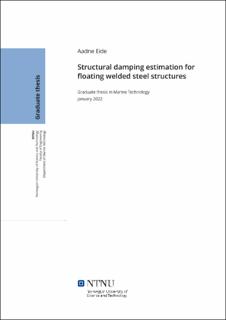| dc.description.abstract | Dempingsnivået er viktig for å bestemme responsen ved nyttige frekvenser i design av store flytende sveiste stålstrukturer. Nåværende praksis er baser på tommelfingerregler, noe som betyr at nøyaktige estimeringer ikke alltid er tilfellet. I tillegg til hydrodynamisk demping, aerodynamisk demping og fundamentdemping kan bidragene fra strukturdemping også være sentrale i oppførselen til strukturen. Strukturdemping kan bli delt inn i den interne matrialdempingen og friksjonsdempingen mellom sammenføyninger.
Denne oppgaven er en rapport på analytisk arbeid, eksperimentelt arbeid og numerisk arbeid som ble gjort for å øke forståelsen om strukturedemping i sveiste stålstrukturer. Det ble gjennomført eksperimenter på en bjelke med forskjellige innfestninger. Innfestningene bestod av en delvis sveist fast innspent ende og en helsveist fast innspent ende. I tillegg ble en endelig element modell laget ved hjelp av Abaqus CAE. Denne var tiltenkt å gjenskape oppførselen til bjelken i eksperimentet. I den numeriske modellen ble augmented Lagrange kontaktformulering benyttet på stål mot stål kontaktflaten mellom bjelken og platen.
For å kunne bedømme nøyaktigheten til de forskjellige metodene ble det utført en statisk nedbøyingstest. De analytisk resultatene, eksperimentelle resultatene og numeriske resultatene ble brukt under vurdering av de antatte matrialegenskapene i det eksperimentelle oppsette. I tillegg ble det gjort vurderinger av mesh og kontaktformuleringen i den numeriske modellen. Videre ble fri vibrasjontester og tvungen vibrasjontester gjennomført for å etablere dempingsratioer. Dempingsratioene ble estimert ved bruk av logaritisk dekrement og half-power point metoden.
De eksperimentelle resultatene indikerer at dempingen øker når den fast innspente enden går fra delvis sveis til helt sveist. Repeterbarheten var derimot ikke bra nok for disse testene. For forsøkene med tvungen vibrasjon var det en klar endring i oppførselene til bjelken under testing, hvor det var observert en reduksjon av resonansfrekvensen underveis. De mest konsekvente resultatene kom fra testene med fri vibrasjon. Siden disse tilsynelatende stemte med tvungen vibrasjon ble et grovt anslag på dempingen funnet. Den numeriske modellen viste lignende oppførsel som under frivibrasjonstestene for delvis sveiset fast innspent ende. Det var derimot ikke nok grunnlag til å trekke en konklusjon om fordelingen av materialdemping og friksjonsdemping. | |
| dc.description.abstract | In the design of large floating welded structures, the damping level is significant in deciding the response at frequencies of interest. The current engineering practice is based on rules of thumb, meaning the need for accurate representation of the damping levels might not always be achieved. In addition to hydrodynamic damping,
aerodynamic damping, and soil damping, contributions from structural damping
may also play a significant role in the behaviour of the structure. Structural damping can be divided into internal material damping and frictional damping in connections.
This thesis presents a report of analytical, experimental, and numerical work done in order to increase the understanding of the structural damping in welded steel structures. The main approach of the work was to conduct laboratory tests on a cantilever steel beam. Experiments were conducted on the beam with different support conditions in the form of a partly welded clamped end and a fully welded clamped end. In addition, a finite element (FE) model was created using Abaqus CAE with the purpose of replicating the beam in the experiments. In this numerical model, the steel-on-steel contact between the beam and plate was modelled using the augmented Lagrange contact formulation.
To assess the accuracy of the different methods, a static deflection test was conducted. The analytical results, experimental results, and numerical results were used in the assessment of assumed material properties in the experimental setup, and the mesh and contact formulation in the numerical. Furthermore, free vibration tests and forced vibration tests were conducted to establish the damping ratios of the beam with different support conditions. Damping ratios were measured using the logarithmic decrement and half-power point method.
The experimental results indicated that the damping increased as the clamped end went from partly welded to fully welded. However, the repeatably was seen as not satisfactory. For the forced vibration tests, there was a clear change in the behaviour of the beam during testing, these were observed as a reduction in the resonant frequency. The most consistent results came from the free vibration tests. Given that these seemed to coincide with the forced vibration, a rough estimate of the damping level of the physical was decided. The numerical model showed similar behaviour to the free vibration tests with the partially welded clamped end. However, there was not enough evidence to make a conclusion on the separation of material damping and frictional damping. | |
